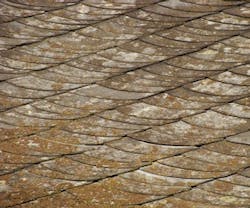If roof leaks are a major contributor to mold development, then keeping water out of organic building materials is paramount to preventing mold evolution. An aggressive leak response program must be established. Leaks must be investigated, origin points determined, and deficiencies remediated in a timely manner or mold infestation is assuredly the expected outcome. Leaks must be stopped within 24 to 48 hours and the wet materials dried out or mold growth is possible.
As important as leak response is, it is nonetheless reactive, and materials get wet prior to identifying the problem. An improved approach would be to develop and preserve an aggressive roof maintenance program. This program should include the following:
Every roof should be periodically inspected to identify deficiencies. It is preferable to perform these inspections in the spring and fall each year. Individuals capable of determining not only apparent immediate problems but also those conditions that could become problems, must perform these inspections. The inspections should concentrate on “high-risk” areas such as around roof hatches, drains, mechanical equipment, and high-traffic areas. In addition to semi-annual inspections, reviews should also be accomplished after severe storms, repair, or alterations to the rooftop equipment or reroofing of adjacent roof areas. Once the deficiencies have been identified, a qualified roofing mechanic must perform repairs in a timely manner.
A properly executed roof maintenance program should not only reduce leaks, thereby minimizing mold development, but as a secondary benefit it should increase roof longevity.
If you suspect mold has infested a building material, a visual inspection is the most important step in identifying a possible mold contamination problem. The extent of water damage and mold growth should be visually assessed, and all organic materials should be investigated.
Extreme care and diligence should be exercised to ensure that hidden and hard-to-see surfaces are thoroughly investigated. Moisture meters should be utilized to determine excessive moisture contents that would possibly promote fungal growth. Bulk sampling is generally not required unless identification of a specific fungal type is desired. Remedial strategies can usually be made on the basis of a visual inspection.
When investigating for mold it is important to following the following safety tips:
- Do not touch mold or moldy items with your bare hands.
- Do not get mold or mold spores in your eyes.
- Do not breathe in mold or mold spores. Consider using appropriate Personnel Protective Equipment (PPE). The minimum PPE should be a respirator, gloves, and eye protection.
Once the extent of mold is determined by visual assessment, remediation is the next chapter in the saga. The goal of remediation is to remove or clean contaminated materials in a way that prevents fungi and dust contamination from leaving the work area and entering an occupied or non-abatement area, while protecting the health of the abatement workers.
Non-porous (metal decks) and semi-porous (wood and concrete) materials that are structurally sound can usually be cleaned. Cleaning is done using a detergent cleaner.
Porous materials such as wallpaper, insulation, acoustical/fireproofing, gypsum boards, and ceiling tiles generally require removal and disposal.
It appears that mold growth and roof leaks are directly related. That being the case, annual roof maintenance may be the first line of defense against mold development. If leaks do exist, they must be investigated and repaired immediately. To stop mold development, we must take the position that roof leaks are not acceptable and that they must not be tolerated. An aggressive preventive maintenance program should not only provide tangible results in mold prevention, but should go a long way in improving public relations as a concerned building owner.
This is an excerpt from the article, “Mold's Relationship to Roof Maintenance,” by Curtis Liscum, senior consultant, Benchmark Inc., Cedar Rapids, IA. To read the complete article, visit (http://www.benchmark-inc.com/articles/Perspective%20Articles/issue52b.html).
